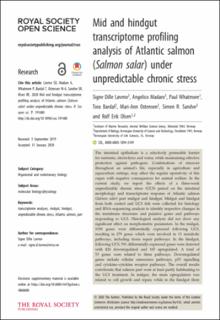| dc.description.abstract | The intestinal epithelium is a selectively permeable barrier for nutrients, electrolytes and water, while maintaining effective protection against pathogens. Combinations of stressors throughout an animal's life, especially in agriculture and aquaculture settings, may affect the regular operativity of this organ with negative consequences for animal welfare. In the current study, we report the effects of a three-week unpredictable chronic stress (UCS) period on the intestinal morphology and transcriptome response of Atlantic salmon (Salmon salar) parr midgut and hindgut. Midgut and hindgut from both control and UCS fish were collected for histology and RNA-sequencing analysis to identify respective changes in the membrane structures and putative genes and pathways responding to UCS. Histological analysis did not show any significant effect on morphometric parameters. In the midgut, 1030 genes were differentially expressed following UCS, resulting in 279 genes which were involved in 13 metabolic pathways, including tissue repair pathways. In the hindgut, following UCS, 591 differentially expressed genes were detected with 426 downregulated and 165 upregulated. A total of 53 genes were related to three pathways. Downregulated genes include cellular senescence pathways, p53 signalling and cytokine–cytokine receptor pathways. The overall results corroborate that salmon parr were at least partly habituating to the UCS treatment. In midgut, the main upregulation was related to cell growth and repair, while in the hindgut there were indications of the activated apoptotic pathway, reduced cell repair and inhibited immune/anti-inflammatory capacity. This may be the trade-off between habituating to UCS and health resilience. This study suggests possible integrated genetic regulatory mechanisms that are tuned when farmed Atlantic salmon parr attempt to cope with UCS. | en_US |
